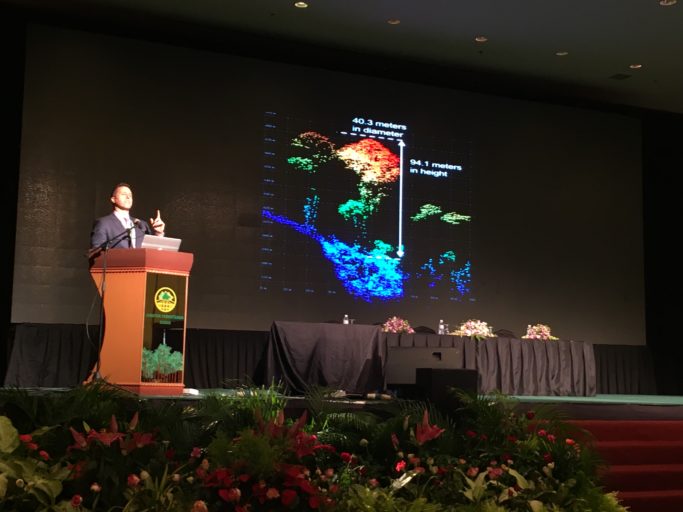- The tallest is a towering 94.1-meter (nearly 309-foot) tree with a canopy that measures 40.3 meters (132 feet) in diameter, discovered in Sabah’s relatively undisturbed Danum Valley.
- Asner was able to observe the tree first-hand during a helicopter ride on Monday to the remote region. “I’ve been doing this for a solid 20 years now, and I have to say, this was one of the most moving experiences in my career,” Asner told Mongabay.
- The tree is in the genus Shorea, though the exact species has yet to be determined. Asner and his colleagues also found 49 other trees taller than 90 meters spread all over Sabah, and plan to visit each of them in the coming weeks.
A few months ago, it was announced that there was a new record for the world’s tallest tropical tree: a Yellow Meranti (Shorea faguetiana) found in Sabah, one of the two Malaysian states on the island of Borneo, that stands some 89.5 metres (about 294 feet) tall.
But that record was not destined to last long. Gregory Asner of the Carnegie Institution for Science at Stanford University announced at the Heart of Borneo conference today that he had not only found a taller tropical tree, but 50 taller trees.
The tallest is a towering 94.1-meter (nearly 309-foot) tree with a canopy that measures 40.3 meters (132 feet) in diameter, discovered in Sabah’s relatively undisturbed Danum Valley. Asner was able to observe the tree first-hand during a helicopter ride on Monday to the remote region. “I’ve been doing this for a solid 20 years now, and I have to say, this was one of the most moving experiences in my career,” Asner told Mongabay.
The tree is in the genus Shorea, though the exact species has yet to be determined. Asner and his colleagues also found 49 other trees taller than 90 meters spread all over Sabah, and plan to visit each of them in the coming weeks.

“This tallest tropical tree, and the 49 runners-up, are truly phenomenal expressions of the power of nature,” Asner said. “Conservation needs inspiration, and these sentinels of the Bornean jungle provide that to us. This discovery is a gift to science, to the people of Sabah and Borneo, and to the world.”
The helicopter flight was funded by film director James Cameron of Avatar fame, as well as the UN Development Programme. Asner described the flight and the moment he first saw the world’s tallest tropical tree with his own eyes:
We flew out of Kota Kinabalu on a Bell Jet Ranger helicopter. After crossing the usual miles and miles of development and oil palm plantations, we broke free into the hilly forests of central Sabah. We aimed directly at the coordinates of the tree marked in our laser scanning data. Ninety minutes later at 110 knots airspeed, we broke over yet another of dozens of remote ridges in Danum Valley, about one minute out from the target. And there it was, sticking out above the rest of the canopy. The crazy thing is that our tallest tree is immediately flanked to each side by a tree of the same species of Shorea, almost as tall! So, there are three trees, like brothers, standing above the rest of the canopy. I almost cried as we circled the tree maybe 10 times before the pilot said we had to go back.
The tree was first discovered when Asner flew the Carnegie Airborne Observatory (CAO) over Sabah to image forests and map animal habitat, carbon stocks, and canopy biodiversity. CAO’s sensors are designed to precisely measure the height and architecture as well as the chemical properties and species identity of trees, according to Asner.
“This technique relies on the 500,000 laser shots per second that we fire out of the bottom of the plane as we fly, which provides a very detailed 3D view of the forest canopy down to the ground level,” Asner explained. “We then digitally process and comb the 3D data for the tallest trees (in this case). The same data are what we use to calculate how much carbon is stored throughout tropical forests.”

Sam Mannan, head of the Sabah Forestry Department, which collaborated with Asner and CAO on the research that led to the discovery, said that he hoped it would help highlight the need to protect Borneo’s rainforests. “Carnegie’s discovery of the world’s tallest tropical tree in our forests of Sabah highlights the importance of continuing and expanding conservation and management in this special region,” Mannan said. “We are proud to protect not only the tallest tree, but also an expanding array of forest reserves, supported by Carnegie Airborne Observatory mapping.”
Dr. Glen Reynolds, the director of the Southeast Asia Rainforest Research Partnership (SEARRP), another partner of CAO’s in the research that led to the discovery of the tropic’s tallest tree, added that the discovery of such a density of enormously tall trees in Danum Valley underscores the importance of retaining the last remaining areas of pristine lowland forest, of which Danum is exemplary. “Trees of this size and age simply don’t exist outside of primary forest — so it’s crucial that the forests which support these now-rare giants is protected,” he said.
It can be hard to visualize just how big 94.1 meters really is, but Asner came up with an adequate comparison. “I tried to find an analogy for how tall this tree is, and I found that the largest toothed whale, the sperm whale, averages 16 meteres in length,” he said. “So this tree is six times that size!”

